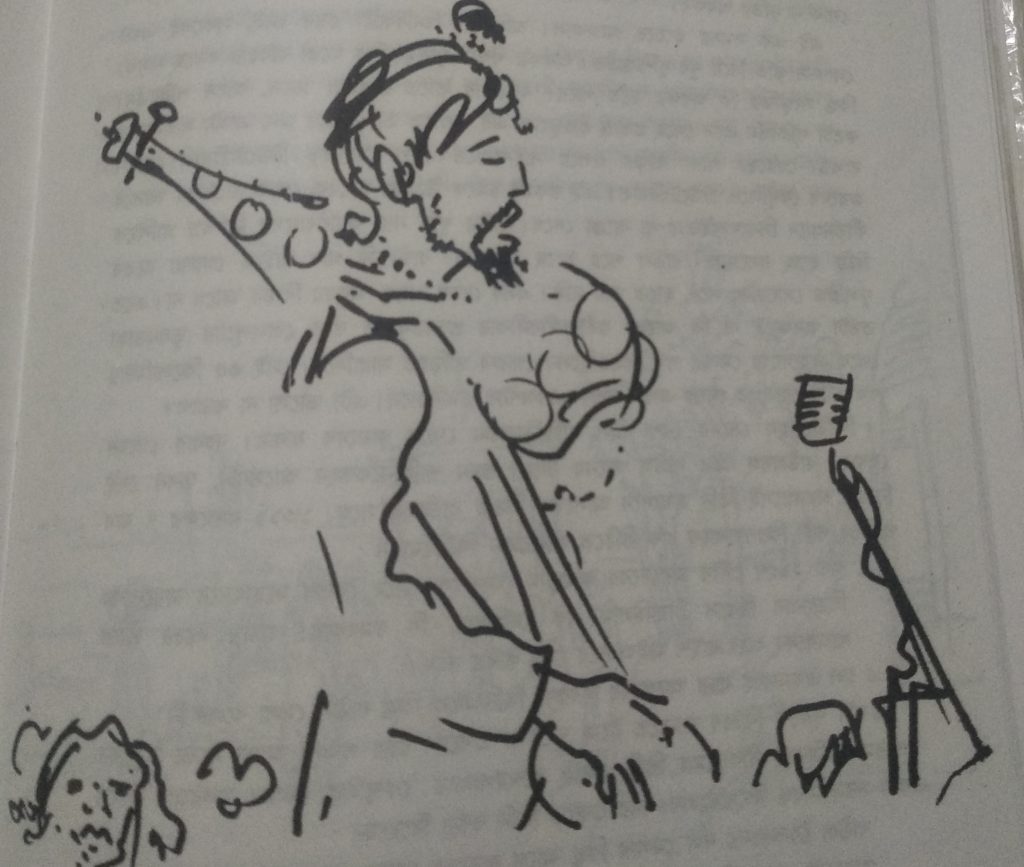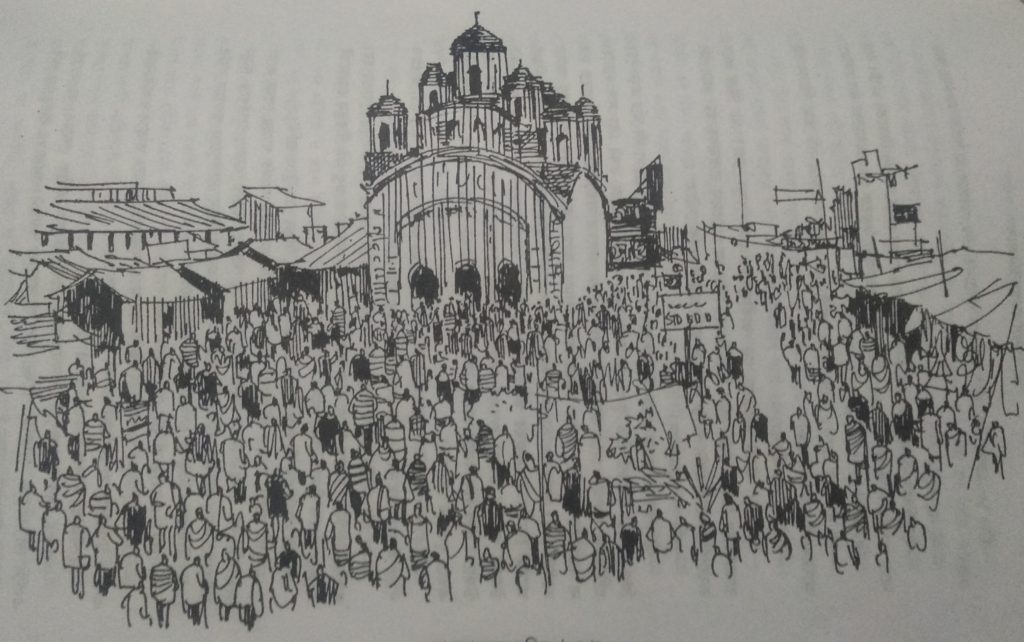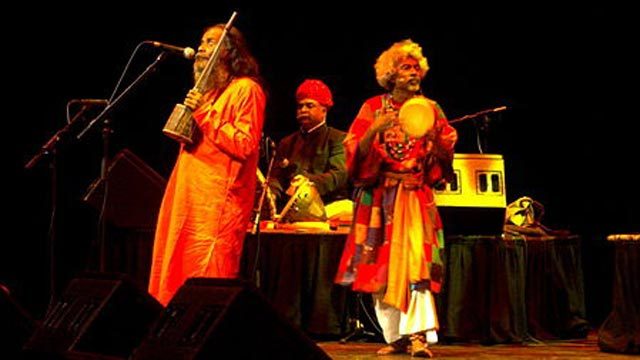While reading about Joydev Kendulir Mela in one of the essays written by the noted Folk Culture researcher, Late Sudhir Chakravarti, we came across a poem written by Arun Kumar Chakraborty, a regular visitor of this annual fair. The poem describes the Joydev er Mela (shortened as well as popularly referred to) as:
“Mariye chhaon pa tene ney holud baliyari
Jol perulei kodomkhondi baul ganer bari
Thik bari noy barir moton janla dorja
Duhat kore khola
Deyal teyal chhutte chhutte chhutte chhutte
Akashe aalbhola
Eikhanetei ganbhashi ek pakhir oraori
Tinte diner bari amar tinte diner bari
Thik bari noy ganer bagan baulbagan bari”
Which means, – Just along the banks of the Ajoy river, there’s a house, a garden house of music, the house that is made up of the Baul songs. One can come here and stay afloat in music for three days.

The Joydev Kendulir Mela (famous as Joydev er Mela) is a unique fair that celebrates poetries, baul songs, and mysticism. It is probably the largest non-religious rural fair in India and the only one of its kind, for there’s no other fair in our country that celebrates the music of the wandering minstrel community, the Bauls.
History of Joydev Fair
There’s no written account on the year of the origin of the Joydev Kendulir Mela. During 17th Century C.E., a Radhamadhab Temple was built by Raja Kirti Chandra of Bardhaman. Most probably, after the temple was built, an annual fair started where the devotees visited after the darshan of Radha Madhav.
Related Post: Sweetmeats from Bardhaman, West Bengal
It is believed that the temple was erected just on the site of poet Joydev’s house. Poet Joydev, who lived during the 12th Century C.E., was one of the nine ratnas (gems) of the King Lakhshman Sena’s court. Gitagovindam was his immortal literary work. The uniqueness of Gitagovindam lies in its essence – it’s in Sanskrit, but the expressed emotions speak that of a Bengali.
The Legend of Joydev Fair
Poet Joydev was a devoted worshiper of Radha Madhav. He used to walk all the way from his village in Kendubilva (now called Joydev-Kenduli) to Katwa for taking a holy dip in the River Ganges, return to his house and worship Radha Madhav.

Devi Ganga, pleased with Joydev’s devotion, granted him a boon. She came in his dreams and said that during Makar Sankranti, every year, she’ll come to him as an upstream in the Ajay River near the Kadamkhandi Ghat. If he takes a bath then, he won’t need to travel to Katwa every morning. Thus, the ritual of the holy dip during the Makarsankranti began.
Cultural Significance of the Joydev Kendulir Mela
As a poet, Joydev created some memorable verses, which were converted into songs mainly by the Bauls. The mysticism of his poems found the mystic voices of the Bauls. To celebrate this union, to celebrate the life and poetries of Joydev, the Bauls from all over India as well as the world, gather in the Akhras of the Joydev Fair ground, adjacent to the Radhamadhab Temple and spend three days amidst verses and songs.
Not only the Bauls, Fakirs and Kirtaniyas are also found performing in the Joydev Fair. It won’t be an exaggeration if said that the Joydev er Mela is the platform to find all the different rural Bengali Music genres. There are Kirtans, Baul songs, Fakiri Songs, as well as the Santhal songs.
Present status of the Joydev Kendulir Mela
Over the times, the Kirtaniyas have outnumbered the Bauls in the Joydev Fair. One of the reasons behind this change might be that many present Bauls belong to the Vaishnava Sect. Along with the Baul songs, they sing the Krishna Kirtans and hence the popularity of Kirtans started increasing slowly. Moreover, the Kirtaniyas are more organised than the Bauls. Therefore, their participations bring forth a comparatively organised format.
Recently, the district magistrate office of Birbhum has given a more systematic structure to the Joydev er Mela. The sanitization system and toilets have improved a lot and the stay facilities are also provided. Although a welcome change, but these structures have dimmed the natural rustic flavour of the fair somewhere. There are fears that the corporate agencies might also come and spoil Joydev Fair’s soul under the garb of facilities and advertisements.
We cannot stop that from happening, can we? With the growing pseudo-consciousness about the prevailing folk culture, the corporatization is a helpless inevitability.
We can only pray that the secret Vrindavan (Joydev is also called Gupta Brindabon) remains as sacred and intimate as it can be, for as long as possible.
“Dekhbi jodi cholo re mon Joydeb jai
Jetha gupto brindabon.
Setha bhoktirosher boiche joar
Tate bhashen koto mohajon.
Raat pohale roj shokale dub dao mon
Ganga bole Ajoy sholile –
Khyapa muchhe jabe moner kali
Korbi jugol doroshon.”
The songs says: If your mind wants, visit the secret Vrindavan at Joydev er Mela. The stream of devotion flows upstream here and the people swim along. Take a dip at the Ajay River, thinking of it as the Ganga. The Radha and Krishna await your presence after you erase all your evil thoughts with the holy dip.
A Few Details about the Joydev Kendulir Mela
Reaching the fair ground
From Kolkata:
Take a train to Durgapur (Hool Express or Black Diamond Express).
Get down at Durgapur and take a Bolpur Bus from Durgapur Railway station and get down at Muchulipara. From there you can take an auto-rickshaw to the Fair Ground.
You can also take a direct bus Joydev er Mela from Durgapur Railway Station.
Apart from Baul songs and Kirtans, the Joydev er Mela is also famous for rural knickknacks. If you want to buy handicraft clay items made by rural artisans, you can get from he
Stay and Food options are basic ones with a place to lie down, and a typical Bengali Veg Thali, please do not expect any luxury affair in this rural place. Non-Vegetarian Food Items are not available in the precincts of the Joydev Fair. You can stay in the numerous Akhras available here or at Durgapur.
Resources:
- Utsabe Melaye Itihase – Sudhir Chakravarti
- Terracotta (Sharat Sonkhya)– A Bi-Monthly Bengali Magazine on Archaeology, Anthropology and Folk-Culture of Bengal


Excellent and informative too